The history of Colombia includes the settlements and society by indigenous peoples, most notably, the Muisca Confederation, Quimbaya Civilization, and Tairona Chiefdoms; the Spanish arrived in 1492 and initiated a period of annexation and colonization, most noteworthy being Spanish conquest; ultimately creating the Viceroyalty of New Granada, with its capital at Bogotá. Independence from Spain was won in 1819, but by 1830 the "Gran Colombia" Federation was dissolved. What is now Colombia and Panama emerged as the Republic of New Granada. The new nation experimented with federalism as the Granadine Confederation (1858), and then the United States of Colombia (1863), before the Republic of Colombia was finally declared in 1886; as well as constant political violence in the country. Panama seceded in 1903. Since the 1960s, the country has suffered from an asymmetric low-intensity armed conflict, which escalated in the 1990s, but then decreased from 2005 onward. The legacy of Colombia's history has resulted in a rich cultural heritage; while varied geography, and the imposing landscape of the country has resulted in the development of very strong regional identities.
Conservatism is a cultural, social, and political philosophy that seeks to promote and to preserve traditional social institutions and practices. The central tenets of conservatism may vary in relation to the status quo of the culture and civilization in which it appears. In Western culture, conservatives seek to preserve a range of institutions such as organized religion, parliamentary government, and property rights. Conservatives tend to favor institutions and practices that guarantee stability and evolved gradually. Adherents of conservatism often oppose modernism and seek a return to traditional values, though different groups of conservatives may choose different traditional values to preserve.

Vicente Ramón Guerrero was one of the leading revolutionary generals of the Mexican War of Independence. He fought against Spain for independence in the early 19th century, and later served as the second president of Mexico. He abolished slavery on a national level during his brief term as president. Guerrero was deposed in a rebellion under Vice-President Anastasio Bustamante.

The flag of Panama was made by María de la Ossa de Amador and was officially adopted by the "ley 48 de 1925". The Panamanian flag day is celebrated on November 4, one day after Panamanian separation from Colombia, and is one of a series of holidays celebrated in November known as the Fiestas Patrias.

A caudillo is a type of personalist leader wielding military and political power. There is no precise definition of caudillo, which is often used interchangeably with "warlord" and "strongman". The term is historically associated with Spain, and with Hispanic America after virtually all of the region won independence in the early nineteenth century.

Manuel Amador Guerrero, was the first president of Panama from 20 February 1904 to 1 October 1908. He was a member of the Conservative Party.
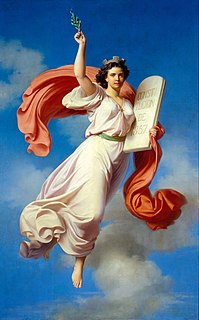
Liberalism in Mexico was part of a broader nineteenth-century political trend affecting Western Europe and the Americas, including the United States, that challenged entrenched power. In Mexico, liberalism sought to make fundamental the equality of individuals before the law, rather than their benefiting from special privileges of corporate entities, especially the Roman Catholic Church, the military, and indigenous communities. Liberalism viewed universal, free, secular education as the means to transform Mexico's citizenry. Early nineteenth-century liberals promoted the idea of economic development in the overwhelmingly rural country where much land was owned by the Catholic Church and held in common by indigenous communities to create a large class of yeoman farmers. Liberals passed a series of individual Reform laws and then wrote a new constitution in 1857 to give full force to the changes. Liberalism in Mexico "was not only a political philosophy of republicanism but a package including democratic social values, free enterprise, a legal bundle of civil rights to protect individualism, and a group consciousness of nationalism." Mexican liberalism is most closely associated with anticlericalism. Mexican liberals looked to the U.S. as their model for development and actively sought the support of the U.S., while Mexican conservatives looked to Europe.
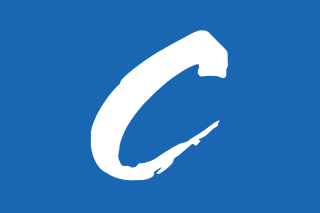
The Colombian Conservative Party is a conservative political party in Colombia. The party was formally established in 1849 by Mariano Ospina Rodríguez and José Eusebio Caro.
Conservatism in North America is a political philosophy that varies in form, depending on the country and the region, but that has similar themes and goals. Academic study into the differences and similarities between conservatism in North American countries has been undertaken on numerous occasions. Reginald Bibby has asserted that the primary reason that conservatism has been so strong and enduring throughout North America is because of the propagation of religious values from generation to generation. This connection is strongest in mainstream Protestantism in the United States and both Protestantism and Roman Catholicism in Canada.
The history of Socialism in Colombia goes back as far as the 1920s and has its roots in the ideas of the Russian October Revolution. Today guerrilla groups, self-proclaimed communists, state that they want to seize state power in Colombia by violent means, and organizations such as the National Liberation Army (ELN) continue their four decades old war with the United States-backed Colombian government.

The Thousand Days' War was a civil war fought in Colombia from 17 October 1899 to 21 November 1902, at first between the Liberal Party and the government led by the National Party, and later – after the Conservative Party had ousted the National Party – between the liberals and the conservative government. Caused by the longstanding ideological tug-of-war of federalism versus centralism between the liberals, conservatives, and nationalists of Colombia following the implementation of the Constitution of 1886 and the political process known as the Regeneración, tensions ran high after the presidential election of 1898, and on 17 October 1899, official insurrection against the national government was announced by members of the Liberal Party in the Department of Santander. Hostilities did not begin until the 11th of November, when liberal factions attempted to take over the city of Bucaramanga, leading to active warfare. It would end three years later with the signing of the Treaty of Neerlandia and the Treaty of Wisconsin. The war resulted in a Conservative victory, and ensured the continued dominance of the Conservative Party in Colombian politics for another 28 years. Colombia's political structure as a unitary state has not been challenged since.
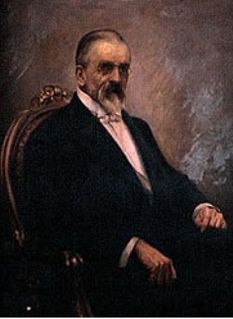
Jose Manuel Cayetano Marroquín Ricaurte was a Colombian political figure and the 27th President of Colombia.
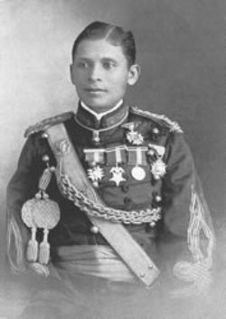
Esteban Huertas López (1876–1943) was a Colombian and later Panamanian military commander.

Gran Colombia, or Greater Colombia, officially the Republic of Colombia, was a state that encompassed much of northern South America and part of southern Central America from 1819 to 1831. It included present-day Colombia, mainland Ecuador, Panama, and Venezuela, along with parts of northern Peru, northwestern Brazil, and Essequibo, Guyana. The terms Gran Colombia and Greater Colombia are used historiographically to distinguish it from the current Republic of Colombia, which is also the official name of the former state.

The separation of Panama from Colombia was formalized on 3 November 1903, with the establishment of the Republic of Panama. From the Independence of Panama from Spain in 1821, Panama had simultaneously declared independence from Spain and joined itself to the confederation of Gran Colombia through the Independence Act of Panama. Panama was always tenuously connected to the rest of the country to the south, owing to its remoteness from the government in Bogotá and lack of a practical overland connection to the rest of Gran Colombia. In 1840–41, a short-lived independent republic was established under Tomás de Herrera. After rejoining Colombia following a 13-month independence, it remained a province which saw frequent rebellious flare-ups, notably the Panama crisis of 1885, which saw the intervention of the United States Navy, and a reaction by the Chilean Navy.
This article is about the history of Panama from 1904 to 1964.
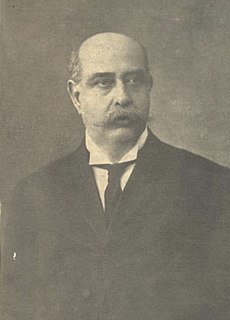
Manuel Espinosa Batista was a Colombian pharmacist turned politician who campaigned for a separate Panama state and became one of "Founders of the Republic". He is known for his philanthropy.
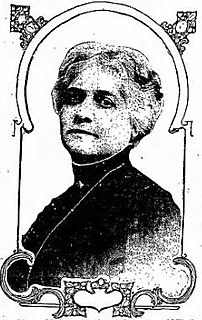
María de la Ossa de Amador was the inaugural First Lady of Panama serving from February 1904 to October 1908. She was one of the creators of the original Panamanian flag and a member of the separatist movement which fought for Panamanian independence from Colombia. She is known as the "Mother of the Nation" and in the corregimiento Parque Lefevre a school was named in her honor. In 1953, for the nation's 50th anniversary, a stamp bearing the likeness of her and her husband was issued by the government of Panama.
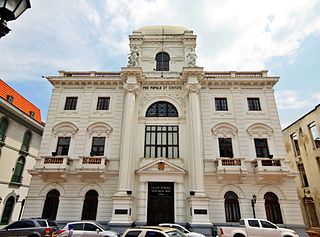
The Museum of History of Panama is a history museum located on the ground floor of the Municipal Palace of Panama City, in the Casco Antiguo of Panama City. This was inaugurated on December 14, 1977 by the anthropologist Reina Torres de Araúz. Currently, it is administered by the Ministry of Culture of Panama. This museum is framed in the context of Panamanian history, encompassing the Colonial Period, the Union to Colombia and the Republican Period.














